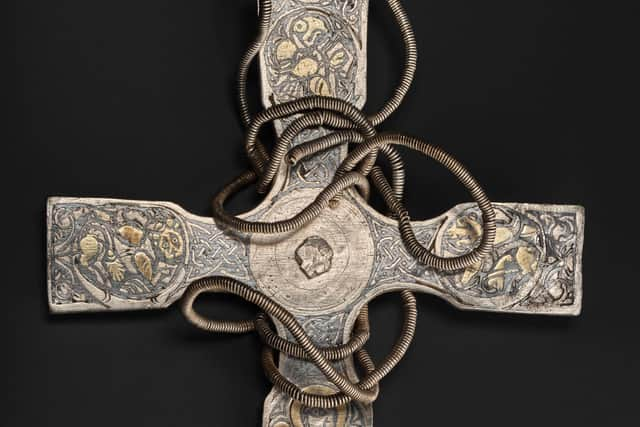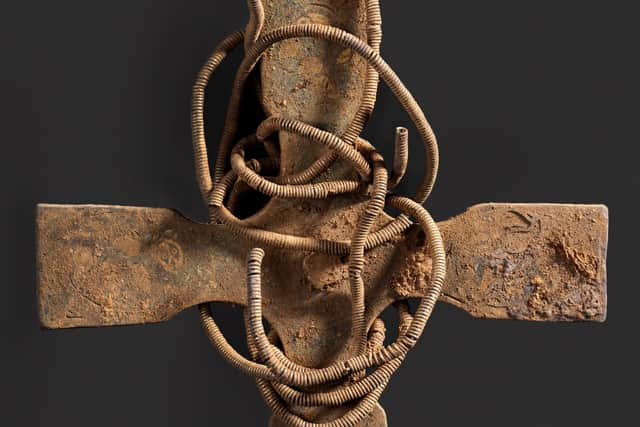Stunning Galloway Hoard cross 'worn shortly before it was buried' 1,100 years ago
The cross’s surviving silver coil chain, which was strengthened through the centre with a thread of animal gut, was wrapped around the highly-decorated cross when it was deposited.
The way the cross and chain were left behind suggests it had been recently used when buried on church land in Dumfries and Galloway around 1,000 years ago.
Advertisement
Hide AdAdvertisement
Hide AdResearchers at National Museums Scotland (NMS) said such crosses were rare in hoards, which were usually loaded with hacksilver to be cut up and sold by weight.


An article by the research team said: “The discovery of a well-preserved pectoral cross placed near the top of the Galloway Hoard was the first sign this was an extraordinary assemblage.
“Pectoral crosses were worn on the chest as a display of Christian belief. This one has the unusual survival of a fine silver wire chain still in place, coiled around the cross and threaded through the pendant fitting. This suggests it had only recently been in use by the time it was buried.”
The cross has been described as a “supreme example” of a late Anglo-Saxon art-style known as Trewhiddle style, which is named after a ninth-century century hoard of metalwork from Cornwall.
Covered in animal and plant forms, the “gleaming” silver surface of the cross was carved and inlaid with pieces of gold.


On each of the crosses four arms, the four evangelists behind the Gospels of the New Testament appear in beautiful detail, with a halo, a winged lion, a winged ox and an eagle, adorning the saints.
Leslie Webster, former British Museum curator and author of 'Anglo-Saxon Art', said: “It’s a very grand object, made for an important individual, who had access not just to considerable wealth, but also to a goldsmith of outstanding skill and artistry; and it is a unique survival of high-status Anglo-Saxon ecclesiastical metalwork from a period when – in part thanks to the Viking raids – so much has been lost.”
Conservator Mary Davis faced a “unique challenge” given the number of materials found in the cross, as well as the dirt and corrosion that had formed over hundreds of years.
Advertisement
Hide AdAdvertisement
Hide AdCocktail sticks, scalpels, needles, brushes, and even porcupine quills were used for removing silver corrosion and dirt without scratching the silver.
Ms Davis spent 80 hours on conserving the cross, with 30 hours spent on the chain alone.
A large circular boss, or gem, was removed from the centre of the cross before it was deposited, with conservators suggesting the cross could have been destined as bullion.
However, it is also a possibility the cross was left as a protective offering of the hoard as a whole.
The article added: “Whatever its role in the Galloway Hoard, the cross would have been a valued possession, produced and worn by those with access to the highest quality ecclesiastical objects.
"It may have been worn as the badge of office for a high-ranking cleric, such as a bishop, abbot or abbess. Imagining how it came to be buried with the Galloway Hoard helps conjure the individuals behind this remarkable collection."
The full article from the conservation team can be found on the NMS blog
A message from the Editor:Thank you for reading this article. We're more reliant on your support than ever as the shift in consumer habits brought about by Coronavirus impacts our advertisers.
If you haven't already, please consider supporting our trusted, fact-checked journalism by taking out a digital subscription.
Comments
Want to join the conversation? Please or to comment on this article.